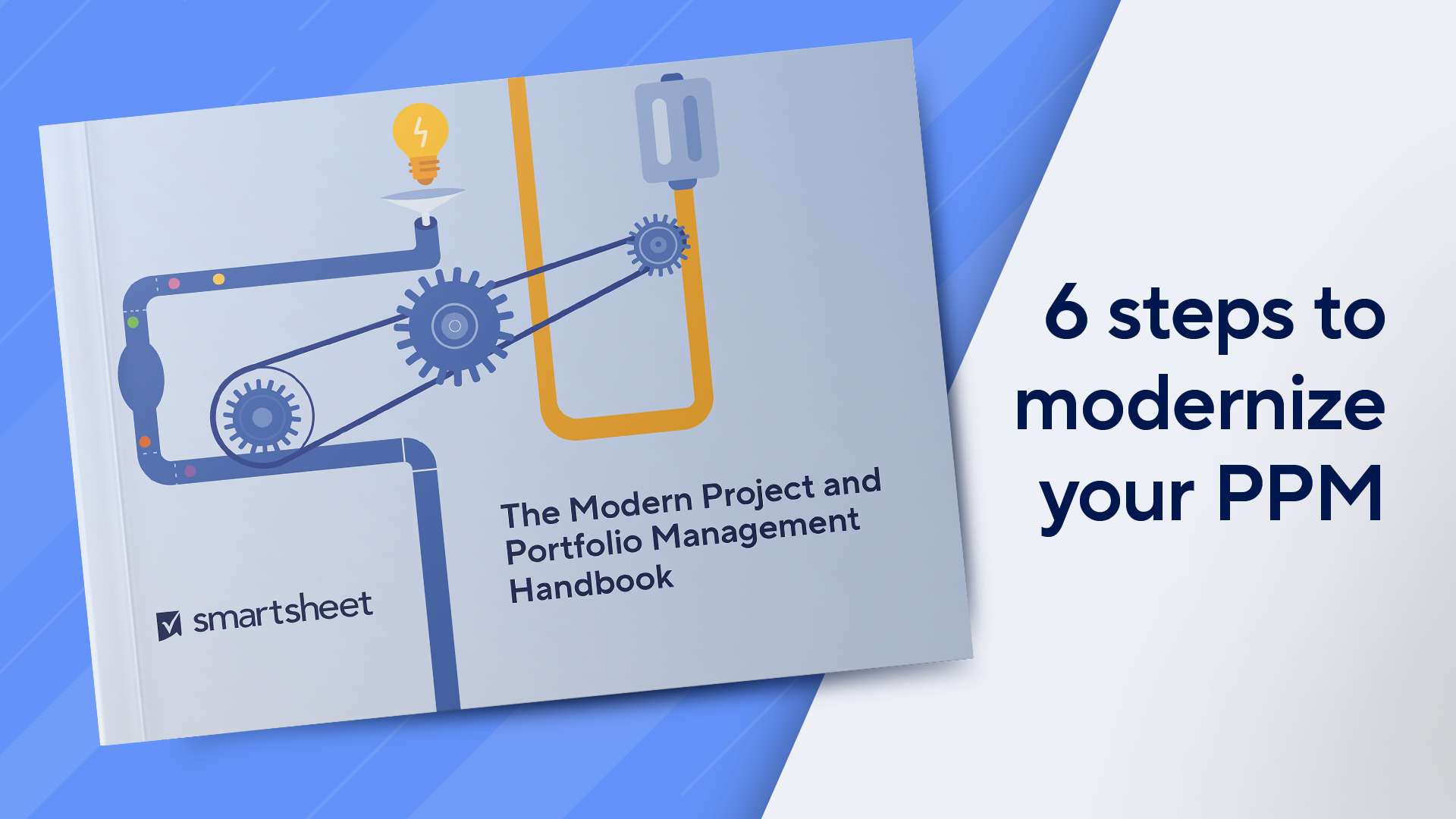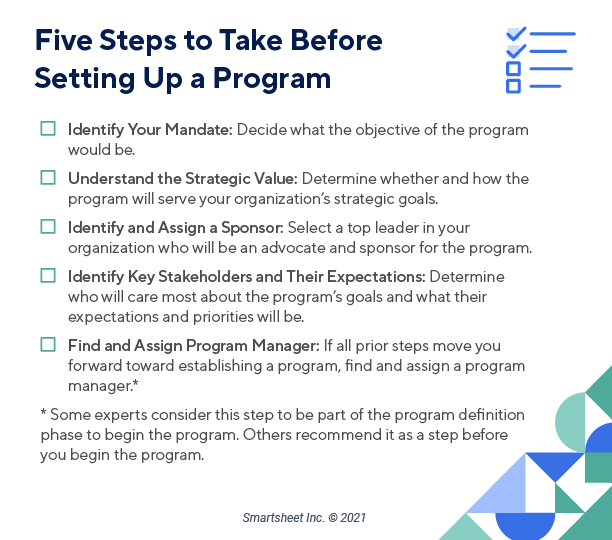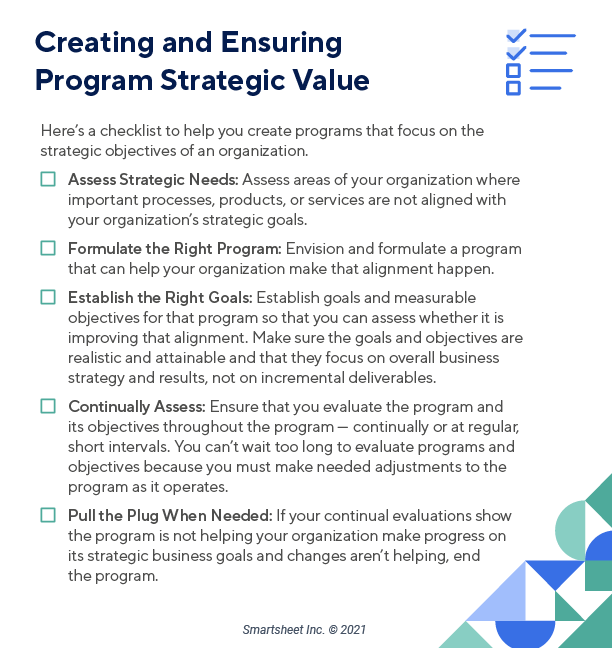What Is the Program Management Lifecycle?
The program management lifecycle includes the basic phases or stages that all programs move through, from conception to closure. At its most basic level, the program lifecycle includes program definition, benefits delivery, and closure.
In some ways, a program management lifecycle is similar to a project management lifecycle. For example, both include initiation, execution, and closure phases or sub-phases. A project management lifecycle, however, aims to finish one specific project on time and within budget, whereas the aim of a program management lifecycle is ongoing and strategic to the organization. A program lifecycle can extend much longer, with a program continuing for years before it’s closed.
Learn more about the differences between program management and project management in our comprehensive guide.
The Modern Project and Portfolio Management Handbook
A modern approach to project and portfolio management can help equip you and your teams to tackle projects and programs at scale.

This handbook will help you:
Identify pain points in your current processes
Learn from examples of businesses using modern PPM strategies
Implement your own updated PPM strategy
First Five Steps to Set Up a Program: Pre-Planning
Experts recommend that organizational leaders take some important pre-planning steps to evaluate a possible program and, if they decide to start the program, to build it on a solid foundation.
Some experts consider these five steps to be part of a separate pre-planning stage, which occurs before the first program management lifecycle phase begins. Other experts consider this pre-planning to be part of the formulation sub-phase, which is part of the program definition phase.
In either case, the pre-planning tasks are similar and will set your program up for success. They include these five key steps:
- Identify Your Mandate: Decide what the organization is trying to accomplish as it considers setting up a program.
- Understand the Strategic Value of the Proposed Program: Ensure you understand how the goal of the program will serve the strategic goals of the organization.
- Identify and Assign the Sponsor: Find a top leader within the organization to sponsor the program. The sponsor must agree with the creation of the program and be committed to its goals.
- Identify Key Stakeholders and Their Interest and Expectations in the Program: Determine which stakeholders within or connected to your organization will care about the program and its goals. Take time to assess and understand the expectations those stakeholders will have for the program’s work. What do they hope the program will accomplish?
- Find and Assign the Program Manager: Identify someone who has the proper skills and experience to manage the program and assign them as your program manager. Learn more about the essential skills needed to become a good program manager in our comprehensive guide to program management.
Program Pre-Planning Checklist
Download Program Pre-Planning Checklist
Microsoft Word
|
Adobe PDF
| Google Docs
You can use a checklist to track the five steps you need to take as you decide whether or not to set up a program.
Program Management Lifecycle Phases
Many experts consider the program management lifecycle to have three primary phases: program definition, program benefits delivery, and program closure. Others suggest a slightly different lifecycle of five or more phases that roughly parallel those three phases.
The following table shows some of the common variations on these program management phases. All of the variations have some similarities in how they outline the development of a program:
Below, you’ll find more detailed information on these three primary phases, as well as expert advice on successfully implementing each phase of your program.
Program Definition Phase
In the program definition phase, the object is to establish the reason for the program and define goals and objectives. In this phase, you also acquire final approvals for the program, set up the program structure, and assign roles.
“An organization has short- and long-term goals,” says Yad Senapathy, founder and CEO of the Project Management Training Institute. “They take these goals and objectives and translate them into an organizational strategy. This organizational strategy typically could spin into multiple sets of portfolios, then have the programs within them. The program then looks up to this organization strategy, looks up to this portfolio, and starts with this one big phase called the program definition phase.”
“The definition phase is centered around the purpose of the program objectives,” says Jake Carroll, the founder of Create Kaizen. “What’s the mission of the program? It’s really answering all of the questions: why are we tackling this versus some other issue?”
“Just at the beginning,” Caroll says, “standing up a program may feel a little bit like project management in that you have some sort of defined scope that you need to get buy-in and investment for. You need to have a little bit of a sense for how long it's going to take to build this.”
Learn more with our comprehensive guide to best practices in program management.
The program definition phase has two sub-phases: program formulation and program preparation. Below is detailed information about these two sub-phases and some tips on how to approach them:
Program Formulation Sub-Phase
Some experts consider formulation tasks to be part of pre-planning before the program definition phase. Other experts, however, consider those tasks to be part of the program formulation sub-phase within the program definition phase. In either case, program formulation involves important steps in establishing the program and setting it up for success.
The main components of the program formulation sub-phase are as follows:
- Create the Business Case: Early in this sub-phase, you will need to make a compelling business case for setting up the program. Why will the cost of the program be worthwhile to the organization? How will it serve the organization’s strategic objectives?
Carroll explains that the business case document needs to answer an important question: “What is the net benefit for the consumer or the business? Otherwise, why would any executive want to sign off on the development of that program?”
“You need to understand what is the business case for even creating this specific program,” says Senapathy. A strong business case, he goes on, will explain, “Here’s the specific business that we have. Here are the overall expected benefits that we need to address as part of this program. The program is trying to deliver these strategic initiatives.”
Use the following strategic goals checklist to help create a program that serves your organization’s needs. This checklist includes five steps to help you ensure that your program stays focused on that ultimate mission.
Download Program Strategic Goals Checklist
Microsoft Word
|
Adobe PDF
| Google Docs
- Secure Program Financing: After you establish the business case, you’ll need to secure all necessary approvals to finance the program.
- Create Program Charter: The program charter will include details on program objectives, potential benefits, and scope, as well as how the program aligns with the organization’s strategic objectives.
“A program management charter is an authorizing document,” Senapathy says. “A charter is saying: Here are certain objectives that the program wants to change. Here's a sponsor who wants to stick in a certain amount of money to this, and the sponsor is putting their weight behind this program. And here's this rough sketch of scope, schedule, and finances. Now we are blessing it. In other words, the program manager is official. The program is official. The objectives are official.”
For additional resources, see our collection of program management templates, including a program charter template that will help you identify the objectives of your program. - Perform Initial Study of Scope: Assess and set out the scope of the program. What work and areas will it and will it not cover?
- Perform Initial Study of Cost: Assess your expectations for startup and ongoing costs of the program.
The types of questions you might ask at this stage, Carroll says, include, “What types of resources are we going to need? Who are we actually taking those resources away from?” He adds, “The cost isn't just the people that I'm gathering. It's also the opportunity costs on whatever they're going away from. It’s a double investment.”
- Program managers must also think in these early phases about short- and long-term costs of projects within the program, says Rick Cherf, associate professor at Washington State University and founder of Total Construction Services, Inc. “A building may last anywhere from 40 to 100 years, depending on the quality of the construction. The first 2 years are the design and construction. Then you manage that facility for the next 38 years. So facility maintenance and maintenance and repair — all of those things are important.”
- Perform Initial Resource Estimate: Along with costs, you will want to determine which resources you can make available to the program.
“That could be planning the execution and what that program actually looks like,” says Carroll. “Who’s going to be involved? What resources might you need internally? That could be resources like people, or it could be resources like money. You also need to develop some sort of timeline for the program.”
If your organization has a program management office, use them as a resource to help with this step and other steps in the formulation sub-phase.
Learn more about program management offices and how they help programs succeed with our comprehensive guide. - Perform Initial Risk Assessment: Identify the likely risks to the program and how you will set up a structure to manage those risks.
“When we bring this team together for a program analysis,” says Cherf, “one of the questions you ask is: What’s going to keep us awake at night?” Your team should perform a detailed assessment of all those possibilities. “Then we put those up on the board and start talking about the critical issues we have to deal with,” Cherf continues.
Cherf shares one story about a program he worked on while building the $2 billion Tacoma Narrows Bridge across Puget Sound in Washington. Program leaders found that 60 percent of the cables were in danger of rusting. “That means you’d have to buy 1.6 times as much cable, which would cost about $20 million more. So they got an insurance program from Lloyds of London, and they also talked to the cable manufacturers to make sure they put a certain kind of coating around the cables. All those little things could impact you. You talk to the people who are responsible for those portions of the program, and you ask them: ‘What’s going to bite us? What do we need to do?’ So when it happens, we're not sitting around going, ‘Oh my God.’ We’ve already thought about that.” - Create Program Plan: The program plan is more detailed than the program charter. It may include plans for governance, communication, resource management, and other details. This step can take place during the formulation sub-phase or during the program preparation sub-phase.
“A program management plan is a how-to,” says Senapathy. “How do you go about implementing the whole program? How do you interact with one another? When a change occurs, is there a system to follow? How do you manage scope within the program? How do you manage the schedule of the program? How does financial management occur within a program?”
“I like to use the word framework,” says Cherf. “It’s a framework. We’re putting together the assumptions, the deliverables, the ‘what do we need to do?’ What kind of framework do we want to set up to make sure that we're operating in the right?”
Program Preparation Sub-Phase
In this sub-phase, your team might finalize the program plan, set up a detailed governance system, and better define the program’s architecture. The purpose of this sub-phase is to get your program ready for launch.
The following are the main components of the program preparation sub-phase:
- Establishing Program Governance Structure: Finalize a structure that your organization will use to manage the program.
- Developing Benefit Realization Plan: Determine how you will assess and measure benefits of the program.
- Identify Program Team: Decide who you want on your program team. Identify potential employees for internal transfer or determine if you will need to find external hires.
- Detail Program Objectives: Write program objectives to help focus the program’s work.
“This is answering the ‘why,’” says Carroll, “and includes internal operations goals as well as external business goals. This also helps with scope creep — when stakeholders want to add different nuances that they prefer but that may not help the original vision and purpose.” - Define and Sequence Activities: Define activities that are important for the beginning of the program. When you complete those early activities, move the program forward to the next required activity.
Carroll points out that the rigor of program definition and early phase analysis will differ between bigger, more established companies and smaller, younger companies.
“I think people pick and choose the components of program definition analysis depending on the needs of their company,” Carroll says. “I did what I would consider a fairly robust lifecycle management for a growth stage company that had a trajectory toward enterprise-level status in the future. The rigor that you need to stand up a program for a company that's in a hyper-growth stage, that’s much more rigorous than for a startup.”
Program Benefits Delivery Phase
The program benefits delivery phase is the phase in which your team performs the actual work of creating the program. This stage begins after program leaders review and approve the program management plan. Some also call this the deployment phase.
In this phase, your team will start work on various components of the program and begin working to meet program objectives. Many experts consider this phase to have three sub-phases, which include component authorization and planning, component oversight and integration, and component transition and closure.
Component Authorization and Planning Sub-Phase
In the component authorization and planning sub-phase, your team will establish the components of the program or the individual projects that comprise the program as a whole. These projects should each address specific objectives that your organization established in the program definition phase. In this phase, your organization may also assign team members to do the work on specific projects within the program.
Component Oversight and Integration Sub-Phase
During the component oversight and integration sub-phase, your teams will begin work on individual projects. This phase also involves oversight to make sure all projects are integrated with each other and with the overall program goals.
The following are some important steps within the component oversight and integration sub-phase:
- Initiating projects that will ultimately deliver benefits
- Managing the transition from your organization’s current state to its new state as the program progresses
- Ensuring that projects meet your organization’s business requirements
- Continually assessing progress against the objectives laid out in your plan
- Identifying and monitoring risks to the projects and the program
- Continually monitoring for issues that might diminish the benefits that you’re expecting the program to produce
- Coordinating the dependencies among projects and ensuring a smooth and efficient timeline
- Coordinating to ensure the program is using resources efficiently
- Communicating with important stakeholders
Component Transition and Closure Sub-Phase
In the component transition and closure sub-phase, your teams will work to successfully finish projects after they’ve delivered their intended benefits. In this third sub-phase, teams will verify that components have met objectives and delivered benefits. Next, they will begin the transition to other ongoing work.
Some experts also recommend a fourth sub-phase called benefits appraisal. The goal of benefits appraisal is to provide an overall assessment of all benefits the program has produced. After this appraisal, leaders might call to end the program because it has met its objectives. On the other hand, they might choose to expand or otherwise change the program.
At this point, Carroll says, organization leaders should ask the following questions: “What’s our return on investment? If we were to look forward, should we either expand the current scope of this program or pivot the scope of the program to tackle a new issue? Or scrap the program completely? What do those different scenarios look like?”
“What you often find,” Carroll continues, “is that you have a lot of existing programs that need to be maintained, or they need to be expanded to grow and serve new user problems, whether the user is a customer to the company or internal employees. You might need further investment. You might need to tweak the way people work in order to get more out of the current investment. I think this is all encompassed in this reflection period.”
Program Closure Phase
The program closure phase is the final phase in the program management lifecycle. In this phase, you will measure program benefits and determine how unresolved work will be completed. This phase is also an excellent opportunity to reflect on the program’s successes and failures and synthesize all the lessons learned. Some experts also call this the dissolution stage.
Many experts consider the program closure phase to have two sub-phases: program transition and program closeout.
Program Transition Sub-Phase
During the program transition sub-phase, your team will assess and document the benefits of the program and ensure that there is a plan in place to complete any unfinished work.
Program Closeout Sub-Phase
In the program closeout sub-phase, the program manager formally releases all resources from the program. This phase may include dispensing of certain technical resources or reassigning team members to new projects. Program leaders document and deliver final records on the program, and the team completes a final program report. This report, also called a lessons learned document, details successes and failures of the program, unforeseen risks, and other information that will be useful as your organization creates and operates new programs in the future.
As you complete the program closeout, be sure to complete the following tasks:
- Retrospective on Program Successes or Failures: An assessment of the program may happen during the component transition or the closure sub-phase of the benefits delivery phase. Either way, you will want to do a final assessment of the successes and failures of any program that is ending.
“There needs to be some sort of retrospective,” Carroll says. “Some people call it a post-mortem, but that's usually more negative. It's a retrospective on how the entire process went. What were our original goals? Did we meet those goals?” - Review of Program Benefits: You’ll want to review benefits of the program, as well as intended benefits that weren’t realized, with key stakeholders.
- Lessons Learned Document: Once you document lessons learned in the final report, determine actions your organization can take to ensure any problems or challenges in the closed program are lessened or eliminated in future programs.
- Program Disband: Programs end for many reasons. but Senapathy says organization leaders often end them for one of two contradictory reasons. In some cases, he says, the organization is reaching, or nearly reaching, the objectives and goals for the program, so it can end. In other cases, the program “isn’t achieving what it needs to achieve and the financial drain is so bad that key executives are beginning to notice it significantly. They just need to pull the plug,” Senapathy says.
Example of Mapping Program Management Lifecycle to Program Activities
All program activities generally fall within these main phases of a program lifecycle. The following table shows details on what specific activities fit within program phases.
Why Embrace an Adaptive Program Management Lifecycle?
By embracing an adaptive program management lifecycle, your team will continually assess how programs are working and adapt plans and strategies as needed. Program leaders who are adaptive are always analyzing program benefits and challenges and assessing new business opportunities.
In an adaptive program management lifecycle, the program management process is iterative. Plans change more frequently, even if it means diverging from the plan that program managers may have written months before.
“Oftentimes, the adaptive nature of taking new information and reacting to it is more important than anything else,” Carroll says.
Take Control of the Project Management Lifecycle with Smartsheet
From simple task management and project planning to complex resource and portfolio management, Smartsheet helps you improve collaboration and increase work velocity -- empowering you to get more done.
The Smartsheet platform makes it easy to plan, capture, manage, and report on work from anywhere, helping your team be more effective and get more done. Report on key metrics and get real-time visibility into work as it happens with roll-up reports, dashboards, and automated workflows built to keep your team connected and informed.
When teams have clarity into the work getting done, there’s no telling how much more they can accomplish in the same amount of time. Try Smartsheet for free, today.




